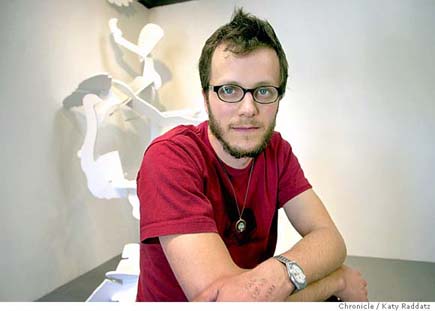
|
Sculptor's
new spin on mailing it in
|
|||
Christian Maychack decided that three pieces, one the size of a hatchet, would make for a comfortably uncrowded show in the Oakland gallery -- and former bait shop -- called Lucky Tackle. Some people on Lucky Tackle's mailing list will have noticed, and some will have overlooked, a fourth work: the show's announcement. "I wanted it to be a piece on its own," Maychack said. "I don't like to photograph work and put it on an announcement, first because I'm usually working until the last minute, but also because there's too much separation between a viewer and a work when you put it on a card. Some people's work suffers more from that than others, but with sculpture there's just too many levels of disconnection." "Chances aren't," he calls the show, and selected recipients received an announcement bearing a sticker that reads "Scratch and See." The face of the
card bears what looks like an ink spatter on a pale blue ground. The
blotches turn out to be spades, diamonds, clubs and hearts of many different
sizes, printed in black. A thin silver coating -- like the coatings on "Scratcher" lottery tickets -- masks some of them. Scratch it away and a playing card jack stares back. Maychack had the cards commercially printed, but silk-screened the silver ink on with help from friends. "I was leaning to a more obvious lottery reference, but I decided that wasn't me," said Maychack, who received his master of fine arts from San Francisco State in 2002. The show's title, which seemed to go with the name Lucky Tackle, came out of a conversation in which "I was thinking about impossibilities," Maychack said. "Chances aren't" might refer to the chastised optimism most young artists take away from a show like Maychack's. The title also suits the fictional quality of the sculptures on view. The most bizarre and elegant of them hangs about chest high on the wall. It has a carved poplar handle that looks like a little human arm and ends in a cluster of leather-covered foam blocks studded with swarms of map pins in black and several shades of yellow and blue. "I had to buy about $60 worth of pins just to get enough of those colors," Maychack said. "If I could subtract myself from the process of all this work and have a tool that would do it all for me, this might be it," Maychack said of the object. "I think of it as a restructuring tool. I wanted it to seem armlike, like it could be an extension of a body, sort of clawlike. The pins became about atomic structures, things breaking up. All these pieces are sort of caught in the process of restructuring or becoming." The armlike form echoes an untitled work across the room. An eccentric faceted form built of lumber and Sheetrock, then painted white, it angles out from the wall close to floor level and rests on a red velvet pillow. It looks like a broken-loose fragment of the wall itself, though the fit between its shape and the cavity in the wall grows more and more obviously rough as one looks. "If the fit was exact, it would look like it had just fallen down," Maychack said of the piece. "I wanted it to seem as if it had twisted and moved around and got itself into position. I wanted it to activate its viewers in maybe the way Martin Puryear activates viewers with really anthropomorphic, idiosyncratic sculptures. The process of getting it to this point was long: many drawings, many different ideas. It got more and more minimal as I went." A third piece comes on more viewer-friendly, but not without ominous undertones. Titled "The Long Goodbye," it clambers up one corner of the room from floor to ceiling. A viewer slowly recognizes the sculpture as a magnified version of the puzzle animals that kids can assemble by notching together cardboard profiles of head, body, legs, tail. Maychack took some of the pocket-size puzzles "and put them on an opaque projector -- gorilla, giraffe, zebra -- and myself." He took a picture of himself, full length, side view, traced it and made it into magnified puzzle pieces in the same heavy-duty foam core from which he made the rest of the sculpture. "All these animals are sort of broken up and headed toward another space," Maychack said of the work's scrambled figuration. Thoughts of bioengineering dance in the viewer's head. "I can see how you might read it that way," Maychack said. "It does take on a reanimated, restructured quality. But I imagine this thing more in a gentle way, like all these things didn't mind, something post-apocalyptic but transcendent rather than painful." The piece persistently read upward to me, though most of its physical and visual weight is down. "Good," said Maychack. "That's exactly what I wanted. It's supposed to seem as if it were headed off and could just go right through the roof."
E-mail
Kenneth Baker at |
|||
